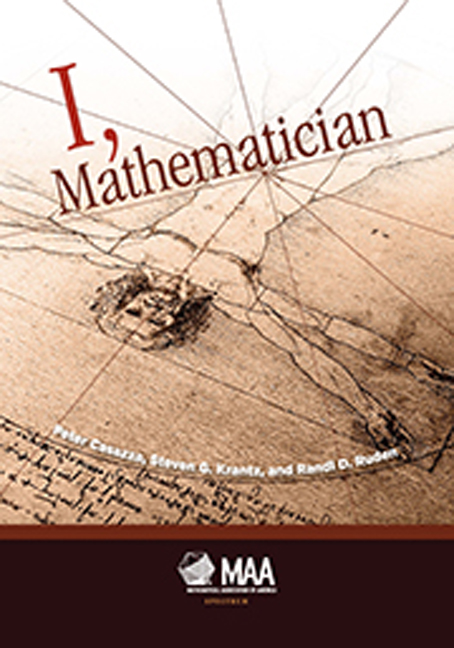Book contents
- Frontmatter
- Contents
- Preface
- Part 1 Who Are Mathematicians?
- Part II On Becoming a Mathematician
- Foreword to On Becoming a Mathematician
- 11 Mathematics and Teaching
- 12 Who We Are and How We Got That Way?
- 13 Social Class and Mathematical Values in the USA
- 14 The Badly Taught High School Calculus Lesson and the Mathematical Journey It Led Me To
- 15 The Psychology of Being a Mathematician
- 16 Dynamics of Mathematical Groups
- 17 Mathematics, Art, Civilization
- 18 Questions about Mathematics
- 19 A Woman Mathematician's Journey
- Part III Why I Became a Mathematician
19 - A Woman Mathematician's Journey
from Part II - On Becoming a Mathematician
- Frontmatter
- Contents
- Preface
- Part 1 Who Are Mathematicians?
- Part II On Becoming a Mathematician
- Foreword to On Becoming a Mathematician
- 11 Mathematics and Teaching
- 12 Who We Are and How We Got That Way?
- 13 Social Class and Mathematical Values in the USA
- 14 The Badly Taught High School Calculus Lesson and the Mathematical Journey It Led Me To
- 15 The Psychology of Being a Mathematician
- 16 Dynamics of Mathematical Groups
- 17 Mathematics, Art, Civilization
- 18 Questions about Mathematics
- 19 A Woman Mathematician's Journey
- Part III Why I Became a Mathematician
Summary
The Village of Righteousness
I was born in 1955 in Taipei, Taiwan. My parents were among the two million mainland Chinese who migrated to Taiwan in 1949 after the Nationalist government lost the civil war to the communists. My father was in the retreating Nationalist Air Force. At birth, I had three brothers and one sister, and two years later my younger brother was born. They named me after their favorite theater in Shanghai (Mei-Chi Grand Theater still exists) which they frequented. My parents always fondly remembered Shanghai, where they lived with my two eldest brothers from 1945–1947, after the war with Japan. They always said jokingly that, since girls do not count in a Chinese family, they did not give much thought to the naming of girls. My sister's name is Mei-Som—Mei means beautiful and Som means a special kind of jade. Mei-Chi means another kind of beautiful jade. All the boys were named in the family tradition with the word Yu in their name, meaning Universe (Fig. 1).
Taiwan in the 1950s was a very unusual place. The island had been under Japanese rule for fifty years, from 1895–1945, and was returned to China only after the war. Four years later, two million mainlanders from all over China fled with the Nationalist government to Taiwan to join the six million Taiwanese.We grew up on a military housing project near the Air Force headquarters, very much segregated from the outside world. At that time there were many government military housing compounds like this to accommodate the hundreds of thousands of Nationalist military personnel and their families who had retreated from the mainland to Taiwan. The housing compound where we lived was called the “Village of Righteousness.” It was called a “village,” but it was near the center of Taipei. Other villages had names like the “Village of Loyalty,” “Village of Recovering,” and “Village of Reconstruction” to reenforce the government doctrines.When I was young, the communist threats were still very real and we were bombarded by government propaganda to be prepared for the communist invasion and to prepare for recovering and reconstructing the mainland next year (always next year).
All the people living in our village were Air Force families. These people came from all over China and spoke various Chinese dialects.
- Type
- Chapter
- Information
- I, Mathematician , pp. 227 - 250Publisher: Mathematical Association of AmericaPrint publication year: 2015

